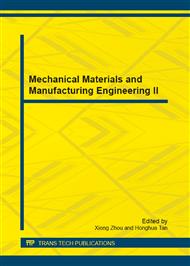[1]
Y.S. Kuo, B.C. Wang, Y.W. Lee, Y.L. Lin, and E. Chang, The Study of Castability And Mechanical Properties of High Strength A201 Aluminum Alloy, CSIST Report (1989).
Google Scholar
[2]
Y.S. Kuo, The Influence of Cooling Rate on the Mechanical Properties and Porosity Content of High Strength Aluminum Alloy Castings , Foundry Technology (Zhuzao Jishu) , Vol. 29, No. 11, (Nov. 2008) 1513-1517.
Google Scholar
[3]
R.A. Entwisetle, J.E. Gruzleski and P.M. Thomas, Development of Porosity in Aluminum Base Alloys, AFS Trans. Vol. 85 (1977) 345-349.
Google Scholar
[4]
G.V. Kutumba Rao, Action of Chills on Solidification and Soundness of Aluminum-Copper-Silicon Alloy Castings, Ph.D. Thesis IIL Madras (1972).
Google Scholar
[5]
J.E. Hatch, Aluminum Properties and Physical Metallurgy, ch. 6, ASM (1984).
Google Scholar
[6]
ASM Metals Handbook Castings, Vol. 15 9th. Ed., 1989, pp.577-580.
Google Scholar
[7]
Y.S. Kuo & E. Chang, The Influence of Thermal Parameter to the Porosity Content of A201 Aluminum Plate Castings, Chinese Foundry Annual Proceeding, (1991), 74-83.
Google Scholar
[8]
N.S. Mahadevan and M.R. Seshadri, Dimensioning of Risers for Long Freezing Range Aluminum Alloys, AFS Cast Metals Research Journal (June 1971) 77-82.
Google Scholar
[9]
Y.S. Kuo, Effects of Solidification Time on Porosity Content in A201 Aluminum Alloy Castings , Advanced Materials Research, Vols. 154-155, (2011) 787-793.
DOI: 10.4028/www.scientific.net/amr.154-155.787
Google Scholar
[10]
U.D. Mallya, and V. Panchanathen, Section Feeding Efficiency Factor - A New Parameter for Soundness Evaluation, AFS Transactions Vol. 82, (1974), 165-168.
Google Scholar
[11]
E. Chang, J.H. Sun and Y.S. Kuo, Design Criterion of Long Solidification Range A201 Aluminum Alloy Castings, , AFS Trans. Vol. 101, (1993), 479-484.
Google Scholar
[12]
W.H. Johnson and J.G. Kura, Some Principles for Producing Sound Al-7Mg Alloy Castings, AFS Transactions, Vol. 67, (1959), 535-552.
Google Scholar
[13]
Y.W. Lee and E. Chang, A study of Riser Feeding Behavior of High Strength A206 Aluminum Alloy, CSIST Report, (1988).
Google Scholar


